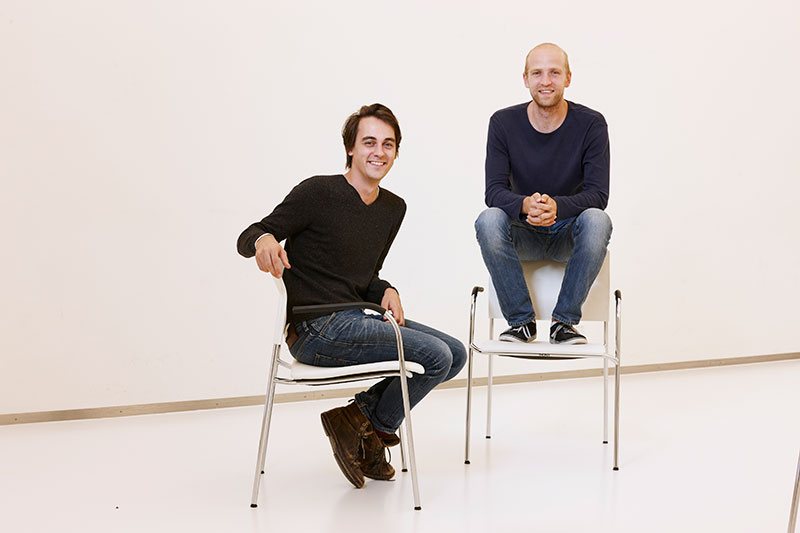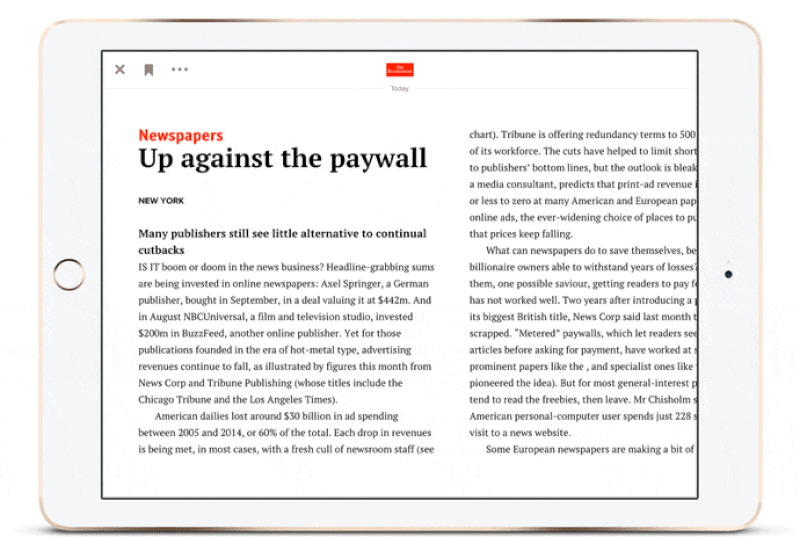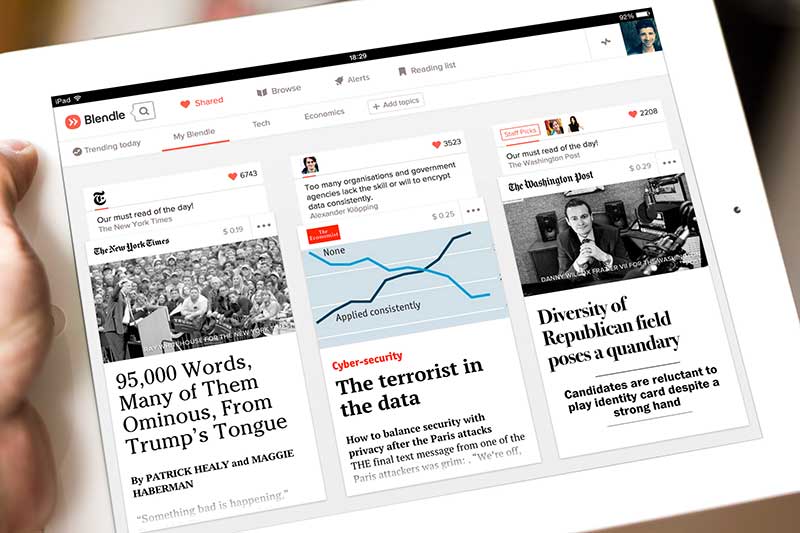When it comes to news, readers want quality journalism. But they don’t want to search for it–even if they do in theory, they likely won’t in practice. They want it fast, they want it easy, and they want it to be great. If they can get all of that, then some readers are willing to pay for it. That’s the kind of service Blendle aims to provide: a curated selection of quality journalism from multiple titles under one roof, in a subscription-free, ad-free experience where readers pay per article. Today the company hit 1 million registered global users.
In an environment where the lion’s share of digital ad dollars have been hoovered up by tech giants, the reader-pays business model is becoming the future of publishing for many news organizations. Insiders have been closely watching Blendle since it launched in The Netherlands in April 2014 to see if it can succeed in creating revenue in an industry beset by digital disruption. CJR spoke with Blendle and some of its longtime publishing partners four months after its beta launch in the US to find out what “1 million” really means.
Blendle is the brainchild of Alexander Klöpping and Marten Blankesteijn, two Dutch journalists who saw what happened to the music business when digital technology tore through it (Napster, anyone?). It wasn’t until Apple made it easy for people to pay for music that was already freely available that the music industry saw significant revenue generated from digital music consumers. Klöpping and Blankesteijn decided to apply the same approach to the journalism industry. “Right now, the barrier to entry in journalism isn’t that it’s too expensive. It’s that it takes more than two seconds to buy something,” Klöpping says.

Alexander Klöpping (left) and Marten Blankesteijn (Photo by Mark Horn, courtesy of Blendle)
After seeing early success with the platform in The Netherlands, Blendle attracted the backing of The New York Times and European publishing giant Axel Springer. Klöpping and Blankesteijn expanded the operation to Germany in September 2015, and in March of this year, Blendle launched in the US with 20 publishing partners, including many of the majors such as The New York Times, The Wall Street Journal, Time, and New York Magazine. The platform initially let in 10,000 beta users; it now has a waiting list that totals more than 25,000.
Among these early adopters was Audry Taylor, a scriptwriter based in LA who came across Blendle after reading a story about journalists’ struggles to get paid for their work; Taylor was struck by the piece and wanted to find a way to contribute.
In order to get people to hand over their credit cards, Blendle has to provide a service that is worth paying for over and above the content it offers. In many ways, Taylor is Blendle’s ideal customer. She appreciates quality journalism, has wide-ranging tastes, and while her news diet is too sporadic to make multiple subscriptions cost-effective, she is willing to pay for an ad-free experience. Taylor is the type of reader Blendle needs in order to survive.
Upon logging in, Blendle initially feels like any other news app that pulls from RSS feeds: Users are presented with a selection of stories that reflect topic areas they indicated interest in during sign-up, such as Tech & Science, Culture & Lifestyle, and Election 2016. If readers prefer to browse an entire publication, however, they can navigate via a PDF version of the newspaper or magazine and click through to individual stories. But most readers navigate via topics, and that’s where Blendle starts to stand out.
Blendle is heavily invested in curation, with four US platform editors and a team of volunteer curators who are specialists in each topic category. Between them, the editors spend around 12-20 hours a day reading so they can surface what they consider to be the best stories to populate the platform’s topics sections and newsletters. “In this sea of noise from Facebook and Twitter,” says Klöpping, “it’s really hard to find the best analysis, the best portraits and original reporting that’s being made every day.”

(Courtesy of Blendle)
Customers can view headlines along with the first few lines of a story before deciding whether to purchase. Prices are clearly marked, ranging from $0.09 to $0.59 apiece, and readers who feel like they didn’t get what they paid for can opt for an immediate refund, which means clickbait headlines don’t work. Initially, customers are given $2.50 to spend on stories, and so Blendle’s challenge is to convert those simply trying out the service into paying customers by topping up their virtual “wallet.” Currently around one in five of those who register end up connecting their credit card to the service to continue reading. Jessica Best, a senior editor and head of Blendle’s US curation team, says the most popular articles on the site tend to be analysis and longer feature writing, as opposed to straight news.
Daily and weekly curated newsletters drive the bulk of traffic to Blendle’s desktop and mobile platforms, and the company has spent a lot of time perfecting its newsletters as a result. A team of a dozen data scientists and journalists are working now on a personalization algorithm, for instance, that matches users’ reading preferences to stories editors have selected. “It’s matching the best stories to the people that want to read them,” says Best. Over time, the Blendle experience should become increasingly customized.
Right now, the barrier to entry in journalism isn’t that it’s too expensive. It’s that it takes more than two seconds to buy something.”
The algorithm isn’t implemented in the US beta yet; instead, the US newsletter features the 10 best stories the editors read each day. Newly released global click-through figures suggest the data scientists are getting something right. Blendle’s global newsletter open rate is almost double the industry standard, according to figures released by MailChimp, and people are clicking through almost three times as often.
Curation is important to Taylor–who says she isn’t “interested in reading articles about what the latest reality show star did yesterday”–but it’s really a combination of factors that she finds appealing. Blendle works for Taylor when she sees an article she wants to read that’s hidden behind the paywall of a publication she doesn’t subscribe to, or when she’s reading on another service and gets fed up with the ads. “I’m the sort of person who would pay a monthly fee for an ad-free Facebook or Twitter,” she says. However, Taylor says Blendle probably won’t be a long-term part of her media diet because of sharing issues. “I just want to share some articles with friends of mine,” she says, “and some of those friends have limited budgets and will not be signing up for Blendle.”
Dutch magazine publisher Wouter van der Meulen’s Vrij Nederland is a legacy print publication that, in 2014, lacked a sound digital strategy. As a news and opinion magazine with an aging print subscriber base, it was having trouble attracting readers to its website. Blendle’s contention that people would be willing to pay for Vrij Nederland’s content online appealed to Van der Meulen. He partnered with Blendle to find out if it was true. “From the beginning, we were really positive,” van der Meulen says. “Because for the Dutch market, it was the first sign people wanted to pay for quality content.”
Vrij Nederland makes use of the Blendle Button—a tool that allows Blendle users to pay-per-article on its own website. Rather than competing with Blendle for subscribers, van der Meulen says Blendle is attracting younger readers to its brand who wouldn’t spring for a full subscription to Vrij Nederland anyway. In that sense, Blendle is partly an exercise in marketing. Van der Meulen estimates that in 2016, the magazine’s net revenue from the service will total close to €200,000. “Which is not a lot, but it’s €200,000-plus compared to zero,” he says, adding, “For us, it’s a way forward.” With Blendle, 70 percent of revenue goes to the publisher, and 30 percent to the platform.
Blendle’s global newsletter open rate is almost double the industry standard, and people are clicking through almost three times as often.
Philippe Remarque, editor in chief of the major Dutch daily newspaper de Volkskrant, is also hopeful about the service, even though the paper has a robust digital subscription offering of its own. De Volkskrant gets more than 80 percent of its revenue from readers (including both print and digital subscriptions), and that number is increasing. Blendle currently provides less than 1 percent of revenue. Still, Remarque considers the partnership worthwhile because he thinks Blendle plays an important role in educating young people about paying for journalism. He also values the unique data and insights Blendle generates about the user behavior of digital news consumers.
Despite their praise for the service, van der Meulen and Remarque acknowledge that Blendle isn’t yet a game-changer. Van der Meulen says that, due to services like Spotify, consumers are primed for flat-rate subscription services, not micropayments. For Blendle to survive in the long-term, “it must be an all-you-can-read model, I think, like Netflix, like Spotify,” he says. “Micropayments are just the first step.” Remarque agrees that a flat-rate subscription would be more popular among consumers, but he counters that it would be suicide for publishers. “It might end that way,” he says, “but at this moment my publisher would never do that.” A flat-rate model would undermine de Volkskrant’s primary revenue stream, and so as long as that’s still growing, the newspaper would have no reason to take that route if it were offered.

(Courtesy of Blendle)
This tension–between what works for consumers and what works for publishers–is a key hurdle in Blendle’s growth strategy, and in the publishing industry as a whole. Many US customers are asking for a flat rate, and Klöpping doesn’t rule it out completely. “We think there’s a real need to have one single way of paying for articles on the Web,” he says. “Whether that’s subscription-based or micropayments-based, I don’t really care.” For her part, Taylor says she would want a lot more choice in the number of publishers on board before any sort of flat-rate subscription would appeal to her.
Joanna Alexandre is the syndication and licensing director for The Economist, another longtime Blendle publishing partner that has stories featured in both the European and US versions of the platform. Alexandre says revenue from single-article sales is going to be incremental to The Economist’s bottom line for the foreseeable future, but she thinks it has a role to play in driving sign-ups to the Economist.com. “Where it’s interesting,” she says, “is [when] people who might not necessarily read our content on other platforms find it on Blendle and then become more interested in subscribing.” She also finds Blendle’s business model more transparent than apps that work on an all-you-can-read model. “As a publisher, by the time that $9.99 has been divided by the aggregator and then the 78 different content platforms, you’re really receiving very, very little revenue for that,” she says. “You’ve really no metrics about how many people are reading your content and whether they think it’s worthwhile.”
It’s still an open question as to whether flat-rate subscription services like Spotify are actually making money. According to a recent article by Hannah Karp in The Wall Street Journal, margins for such streaming services are tight and, despite 30 million paying subscribers, Spotify posted operating losses of $200 million last year. The real winners in music-streaming services are the tech companies who use the offering to attract paying customers to other services, such as devices or online shopping, writes Karp. Blendle has oft been dubbed “iTunes for news,” but now that the originator of that business model has entered the news aggregation market with its Apple News app, Blendle will likely find itself facing some stiff competition.
Apple News launched in the US, the UK, and Australia last year. There isn’t currently a market overlap with Blendle, but it is one of its likely competitors, along with Flipboard, SmartNews, and the numerous other apps playing in the news aggregator space. Already, Apple News has 60 million active monthly users and 2,000 titles. It, too, employs editors to provide a layer of curation on top of a personalized experience that is largely algorithmic, and it’s rumored that its next iteration in iOS 10 will supporting subscriptions to certain titles within the app, although not micropayments.
Blendle has to provide a service that is worth paying for over and above the content it offers.
Blendle knows it’s facing an uphill battle with no guarantees of success. Some people may be willing to pay for journalism online, but the recent Reuters Institute Digital News Report shows that the number of people paying for news on the Web in the US dropped last year from 11 percent to 9 percent, and that no English-speaking country has a payment rate of more than 10 percent. Indeed, how Blendle will move forward with other English-speaking markets is a key question for the company. For now, it will start by introducing English-language products that aren’t US-based into the US beta.
The growth demonstrated by its 1 million registered users signals Blendle as a promising new media model with a long road ahead. In that way, it embodies all of the conundrums of the industry. “I do think they’re here to stay because their user numbers are going up and revenue is also going up,” says Remarque, “but it’s a struggle because it’s a new way of reading and not everyone is inclined to do that.”
What comes through from talking to longstanding publishing partners is an appreciation that Blendle is willing to get its hands dirty to try to work out all of the tensions and contradictions of the media industry as we currently know it. “For a digital leap into the future, you need those outsiders who are brazen enough to think up such a business model and encourage everybody to take part,” says Remarque. Klöpping acknowledges that Blendle is essentially an experiment. “We haven’t found a silver bullet. It’s a process,” he says, adding, “It’s certainly possible that we fail. But if there’s ever been a time to do this—and if there ever has been a company to do this—I think we’re the right one at the exact right moment.”
Shelley Hepworth , formerly a CJR Delacorte Fellow, is Technology Editor at The Conversation in Australia. Follow her on Twitter @shelleymiranda.

